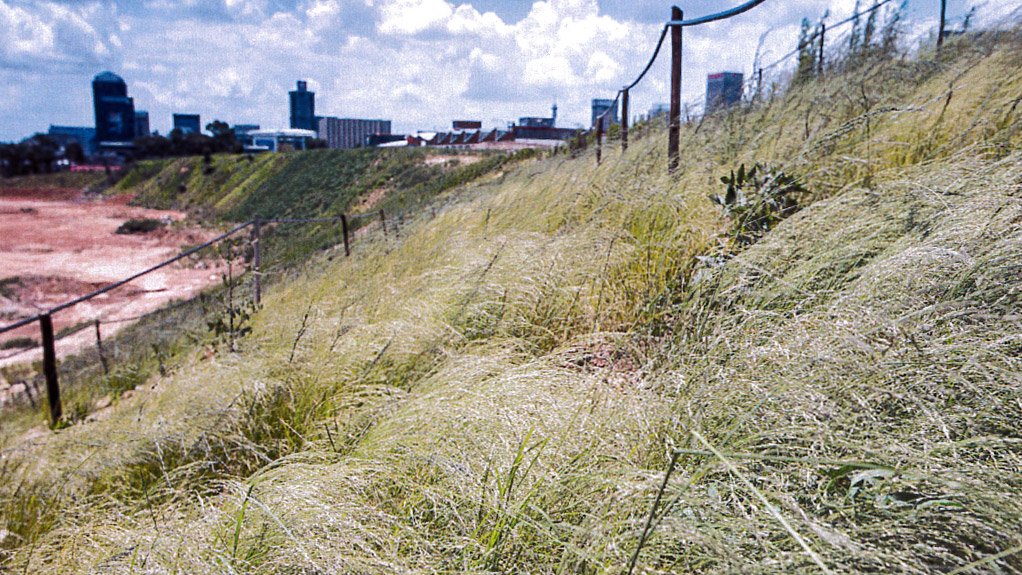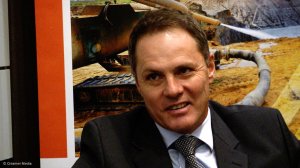JOHANNESBURG (miningweekly.com) – Surface mining company DRDGold, which has spent more money on vegetating tailings dams in the last ten years than it has paid dividends to shareholders, is seeing its dump vegetation effort going up in smoke at the same time as it comes under criticism from a leading nongovernmental organisation (NGO) for allegedly failing to suppress dust adequately.
After presenting 41% lower operating profit of R256.8-million in the 12 months to June 30, DRDGold CEO Niël Pretorius told investors, analysts and journalists that vegetation costing hundreds of thousands of rands per hectare is being burnt, along with the irrigation systems used to keep the vegetation moist.
He extended an open invitation to the Bench Marks Foundation, which has been criticising DRDGold for allegedly failing to suppress mine dump dust, to engage in conversation with the company, adding that only five dust exceedances were measured in the 12 months to June 30 compared with 22 in the previous year, reflecting the positive impact of the company’s ongoing vegetation programme.
The Bench Marks Foundation is an independent NGO mandated by churches to monitor the practices of multinational corporations. (Also watch attached Creamer Media video).
DRDGold’s resource consists solely of tailings dams that are scattered in and around the Johannesburg landscape. From an initial 300 of them, they are now down to 180, with an estimated 120 tailings dams that used to exist removed by the combined efforts of DRDGold and past participants.
“I don’t know why there’s a reluctance on the part of the Bench Marks Foundation to talk to us. I don’t understand why they refuse to come and look at our information. I don’t understand why they're reluctant to engage with us, to see what it is that we are doing and what we’re going to be doing. I’m perplexed by their position," Pretorius remarked, adding that the company and the NGO had similar objectives but were unable to find one another in collaborating.
“There’s only one institution in Johannesburg at this point in time that is spending money and dedicating resources towards either the removal of tailings dams or the vegetation of tailings dams. DRDGold has spent more money on vegetating tailings dams in the last ten years than it has on paying dividends, and it will continue to do so until we’re finished our rehabilitation.
“I fail to see the downside on the part of an NGO to come and talk to us. The invitation is there – an open invitation to government, local and provincial, and an open invitation to any of these NGOs to come and talk to us and tell us their concerns,” Pretorius told Mining Weekly Online.
DRDGold set out in 2007/8 to increase the density of the vegetation at its tailings deposition facility near Soccer City in response to the flouting of buffer guidelines.
That greater vegetation density is now the norm, aimed at the greater suppression of dust.
A large percentage of the side slopes of tailings dams have been densely vegetated and the tops fully vegetated. (See pictures in Creamer Media video).
DRDGold has largely met its objective of each year halving the volume of dust coming off the tailings dams and expects to complete the vegetation of its remaining dumps by 2022.
It has 97 monitoring points in and around the Johannesburg area where it monitors and measures the amount of dust that finds its way into surrounding residential areas.
This year, a mere 0.8% of those of 1 400 measurements taken exceeded the acceptable level for residential purposes.
In addition to vegetating, DRDGold also removes old mine dumps, as has been done close to the Riverlea community, which was one of the four communities identified in the Bench Marks Foundation report as being dust-impacted.
“The people of Riverlea used to have big mine dumps right next to them. Those have been removed completely, with the last bit of overburden being trucked away.
“Looking at the prevailing wind direction, that was a big source of dust for that community. Over and above the removal, there’s the vegetation process that is turning out to be very successful.
“We have two frustrations, though, with the vegetation process. The one is apparently it’s fun to burn the vegetation down. People go and they set fire to vegetation that costs hundreds of thousands per hectare to establish, for no other reason than to look at a fire, or maybe there is a more sinister motive, I have no idea.
“It just destroys that vegetation and it also destroys the irrigation used to keep the vegetation wet. If the irrigation gets burnt down within the first three years, it’s so much more money that we’ve got to spend, which then slows down the rest of the vegetation process," Pretorius said.
DRDGold vegetated 35 ha of Crown tailings in the 12 months to June 30, 34 ha in the corresponding period of its 2016 financial year and the process will continue until all the slopes have been vegetated.
“If you’re travelling into Johannesburg from the south, as you come through the flyover right next to Soweto, the vegetation almost frames those tailings dams and it looks wonderful compared with what it used to look like. There’s not a speck of sand to be seen. It’s a beautifully vegetated piece of irrigated pasture, and that’s the way the entire thing is supposed to look, and that’s how it will all look come 2022, once we’ve managed to vegetate all those slopes,” Pretorius said.
Three new reclamation sites in the central and east of the Johannesburg have been commissioned in the 12 months to June 30 and preparation has started for the commissioning of a fourth by the third quarter of financial year 2018.
The cost and time required to mechanically reclaim material from the legacy sites were greater than anticipated.
This, together with the knock-on effect of treating the low-volume material through the normal gold recovery circuit and a drop in the average gold price received combined to impact negatively on the company’s operating and financial performance for the year, Pretorius added.
In a media release to Mining Weekly Online on Tuesday, the Bench Marks Foundation made the point that its latest report on four Soweto communities impacted by mining included substantial research, both from its own field workers and from scientific, university and Chamber of Mines sources. Community responses were compiled from 400 questionnaires that were distributed.
The four communities are Riverlea, Diepkloof, Doornkop and Meadowlands.
Responding to DRDGold’s disappointment that foundation had failed to engage with it, lead researcher David van Wyk, the author of the report, said the Riverlea Community Forum (RCF) had tried desperately to communicate with DRDGold, but had been unable to do so on a regular basis.
The NGO added that its researchers had experienced difficulties in engaging with the mining companies and to get members of mine management to respond to correspondence directed through, for example, the RCF, with the exercise requiring several follow-up telephone calls and emails.
In an interview Mining Weekly Online, Pretorius said the original guidelines for the management of the mine dumps in and around Johannesburg were based on the maintenance of a buffer zone.
But such zones had not been maintained, resulting in communities moving closer and closer to dumps. As a consequence, many of the original environmental guidelines had been rendered inadequate to limit the impact of dust on surrounding residential areas.
The foundation criticised DRDGold’s alleged defence of unsignposted and unfenced mine dumps is being “wholly inadequate”.
The NGO rejected the claim that dust from dumps posed no health risk, while DRDGold has made the point that its staff working on the dumps are not showing any signs of respiratory ailments.
EMAIL THIS ARTICLE SAVE THIS ARTICLE ARTICLE ENQUIRY
To subscribe email subscriptions@creamermedia.co.za or click here
To advertise email advertising@creamermedia.co.za or click here












